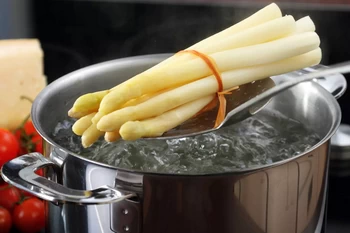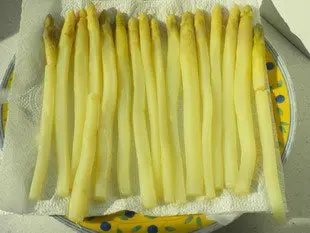This site uses only a few technical cookies necessary for its operation. By continuing to browse, you accept their use.
To find out more...
To find out more...
Should asparagus really be cooked in bunches?

You'll probably read recipes here and there explaining how to cook asparagus "en botte", i.e. in a small package (the famous "botte").
Is this really the right way to cook asparagus?
Is this really the right way to cook asparagus?
7,715 5/5 (1 reviews)
Keywords for this post:AsparagusCookingTipBundleLegendLast modified on: May 22th 2024
Should asparagus really be cooked in bunches?
"Botte" cooking
This is a method familiar to all professional cooks when cooking asparagus: peel the asparagus, tie it together with string or a rubber band to form a small bundle, the "botte", and plunge it into boiling salted water.
Remove the bundle from the water, drain and cut the string.
Is this a good method?
This method seems like a good idea, but it's not. In practice, doing it this way leads to problems with cooking levels.- Bunching the asparagus increases the overall cooking time, with the asparagus around the edges cooking faster than the asparagus in the middle, which takes longer.
- This difference in cooking time means that some asparagus (again, those in the middle) may be overcooked, while those in the middle may be undercooked.
- If you want to check doneness with the tip of a knife, it's almost impossible with the asparagus in the center, unless you go through the asparagus in the middle.


To sum up: don't cook your asparagus in bunches, as they won't cook as evenly as conventional asparagus.
Lasts posts
Butter vs. grease
We often read in a recipe where a pastry is put into a mould that, just before pouring, the mould should be buttered or greased. But what's the difference between these 2 terms?December 1st 20256535
Getting out of the fridge early
Very often when you're cooking, you need to take food or preparations out of the fridge, to use them in the recipe in progress. There's nothing tricky about this: you just take them out of the fridge and use them, usually immediately, in the recipe. But is this really a good method?November 24th 20259545
Who's making the croissants?
When you look at a bakery from the outside, you naturally think that in the bakery, the bakers make the bread, and in the laboratory, the pastry chefs make the cakes. It's very often like that, with each of these professions having quite different ways of working, but sometimes there's also one...November 23th 2025862
Oven height
When we put a dish or cake in the oven, we naturally tend to put it on the middle shelf, and that's what we usually do. But in some cases, this position and height can be a little tricky, so let's find out why.October 8th 20252,4435
The importance of sieving
In recipes that use a fine powder (flour, powdered sugar, etc.), you'll often see the advice to sift before using it. To sift is to pass the powder in question through a sieve (a very fine strainer) before incorporating it into your recipe. It's often advice, but is it really useful?September 3rd 20257,3323
Other pages you may also like
The return of the "Norman hole"
You maybe know the "trou normand", this old gastronomic custom typically French which consists in taking a (small) glass of calvados, generally between the last course and the dessert? It's something that seems a bit anachronistic nowadays, having a glass of an alcohol of more than 60° in the...December 18th 202114 K4.8
Cleaning endives
If you buy your endives elsewhere than in supermarkets, and in this case the best is of course from a market gardener, he or she is the one who planted and harvested them, in this case you will have endives full of earth or sand, depending on where they were grown, which is normal and reassuring, we...March 24th 202026 K4.6
Do you know Yotam Ottolenghi?
Do you know Yotam Ottolenghi? Maybe not, in which case let me tell you a little about him.December 19th 20207,9324.8
The first breads of humanity?
I have already told you in a previous article the beautiful story of the croissants, but do you know what it is about the bread, who "invented" it, where and when? Well, you can imagine that recent discoveries, in 2018, have profoundly changed the history of bread.February 16th 201914 K5
The preservation of bread
Eating fresh bread is always a delight, the crust crumbles deliciously, you take full advantage of the taste of your bread (80% of this taste is in the crust), it is a fleeting moment to enjoy. Who hasn't already eaten the crouton or croutons of his baguette, on the way back from the bakery? ...June 11th 202214 K4.7
Post a comment or question
Follow this page
If you are interested in this page, you can "follow" it, by entering your email address here. You will then receive a notification immediately each time the page is modified or a new comment is added. Please note that you will need to confirm this following.
Note: We'll never share your e-mail address with anyone else.
Alternatively: you can subscribe to the mailing list of cooling-ez.com , you will receive a e-mail for each new recipe published on the site.









